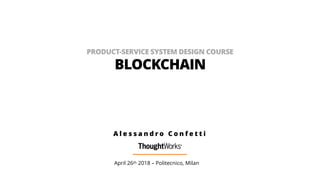Blockchain
- 1. PRODUCT-SERVICE SYSTEM DESIGN COURSE BLOCKCHAIN April 26th 2018 ŌĆō Politecnico, Milan A l e s s a n d r o C o n f e t t i
- 2. 2 Image from Julia Donaldson's books ŌĆō in pictures Alessandro Confetti - April 26th 2018 ŌĆō Politecnico, Milan THERE IS NO SUCH A THING AS A BLOCKCHAIN
- 3. 3 Alessandro Confetti - April 26th 2018 ŌĆō Politecnico, Milan Bitcoin's Academic Pedigree By Arvind Narayanan, Jeremy Clark Communications of the ACM, Vol. 60 No. 12, Pages 36-45 10.1145/3132259
- 4. 4 Alessandro Confetti - April 26th 2018 ŌĆō Politecnico, Milan Courtesy of blockchainhub.net
- 5. 5 Alessandro Confetti - April 26th 2018 ŌĆō Politecnico, Milan Courtesy of blockchainhub.net
- 6. 6 Alessandro Confetti - April 26th 2018 ŌĆō Politecnico, Milan Cryptographic Hashes and Bitcoin By Kalle Rosenbaum Chryptography CRYPTOGRAPHIC HASH FUNCTION
- 7. 7 Alessandro Confetti - April 26th 2018 ŌĆō Politecnico, Milan Bitcoin's Academic Pedigree By Arvind Narayanan, Jeremy Clark Communications of the ACM, Vol. 60 No. 12, Pages 36-45 10.1145/3132259 Chryptography
- 8. 8 image from the work of Paul Baran, On Distributed Communications Networks 1964 Alessandro Confetti - April 26th 2018 ŌĆō Politecnico, Milan P2P Network
- 9. 9 Images from Evolving terminology pt. 2: topology vs ownership January 10, 2016 Alessandro Confetti - April 26th 2018 ŌĆō Politecnico, Milan P2P Network
- 10. 10 Alessandro Confetti - April 26th 2018 ŌĆō Politecnico, Milan Ok, I need a blockchain, but which one? By Pavel Kravchenko Sep 26, 2016 Game Theory
- 11. 11 Alessandro Confetti - April 26th 2018 ŌĆō Politecnico, Milan Ok, I need a blockchain, but which one? By Pavel Kravchenko Sep 26, 2016 Game Theory OPENNESS CONSENSUS ANONYMITY IMMUTABILITY SCALABILITY Permissionless/Public PoW High High Low Permissioned/Public PoS High Moderate Moderate Permissionless/Public FBA Moderate Moderate Moderate Permissioned/Private PBFT/Multisignature Low Low Low
- 12. 12 QUESTIONS TO ASK BEFORE YOU START ŌĆó Who can set or change the rules of the protocol? ŌĆó Who runs the nodes and pay for them? ŌĆó Who validates the block and at which cost? ŌĆó Who can read and/or write the blocks? Alessandro Confetti - April 26th 2018 ŌĆō Politecnico, Milan
- 13. 13 CHALLENGES TO SOLVE BEFORE GOING PUBLIC ŌĆó What is the service actually enabled by the blockchain? ŌĆó What hw, sw, bandwith is the user required to own? ŌĆó How and where the userŌĆÖs private keys are stored? ŌĆó How and where the userŌĆÖs assets are stored?
- 14. 14 Alessandro Confetti - April 26th 2018 ŌĆō Politecnico, Milan
- 15. 15 Alessandro Confetti - April 26th 2018 ŌĆō Politecnico, Milan BLOCKCHAIN for social impact moving beyond the hype Stanford Graduate School of Business 2000 2008 Implementing Organization Type Numberofinitiatives Unknown Foundation Government Nonprofit or Academia For-Profit 2010 2011 2012 2013 2014 2015 2016 2017 2018 our research captured which applications have already begun to demonstrate proven social impact, which industries and use cases are more or less advanced, and what we should be learning from the hundreds of test cases, pilots, and experiments that are using blockchain for social impact. A surge in new projects, organizations, and platforms oriented toward the use of blockchain technology began in 2013. Figure 1: Year Founded by Implementing Organization Type
- 16. 16 Alessandro Confetti - April 26th 2018 ŌĆō Politecnico, Milan BLOCKCHAIN for social impact moving beyond the hype Stanford Graduate School of Business in the early days ŌĆö 34% were started in 2017 or later, and 74% are still in the pilot or idea stage. But, 55% of social-good blockchain initiatives are estimated to impact their beneficiaries by early 2019. Fifty-five percent are estimated to have an end impact on their beneficiaries by early 2019. Figure 2:Time Frame for Proof of Impact Democracy and Governance initiatives are the furthest along, with 62% of all projects expected to have demonstrated impact in the 0% 10% 20% 30% 40% 50% Time Frame for Proof of Impact 0ŌĆō6 months Unknown2+ years 1ŌĆō2 years6ŌĆō12 months Philanthropy, Aid, and Donors Energy, Climate and Environment Land Rights Financial Inclusion Agriculture Health Democracy and Governance 60% 70% 80% 90% 100%
- 17. 17 Alessandro Confetti - April 26th 2018 ŌĆō Politecnico, Milan BLOCKCHAIN for social impact moving beyond the hype Stanford Graduate School of Business Blockchain is most often used to facilitate payments and verify records. Figure 5: Primary Ways in Which Blockchain Is Used Blockchain is most often used to facilitate payments and verify records. The most common use cases for blockchain initiatives are payments and money transfers (25%) and records and verification (26%). BlockchainŌĆÖs most popular primary benefits are being able to reduce risk and fraud (38%) and increase efficiency (24%) Reducing risk and fraud is seen as Records and Verification Payments and Money Transfers Platforms and Marketplaces Digital Identity Various Supply Chain Management Smart Contracting Percentage of Catalogued Initiatives Reduction of Risk/Fraud or Increase in Integrity/Transparancy Increased Efficiency
- 18. 18 Alessandro Confetti - April 26th 2018 ŌĆō Politecnico, Milan BLOCKCHAIN for social impact moving beyond the hype Stanford Graduate School of Business Blockchain for Social Impact 4Stanford Graduate School of Business ŌĆó Reducing risk and fraud is seen as blockchainŌĆÖs primary benefit. Figure 6: Primary Benefits of Using Blockchain Smart Contracting Percentage of Catalogued Initiatives Percentage of Catalogued Initiatives 35% Increased Scale / Reach New People Unknown Enable a Process or Action That Was not Possible Before Reduction of Risk/Fraud or Increase in Integrity/Transparancy Other Increased Efficiency Reduction of Costs
- 19. $ tail -f questions 19 Alessandro Confetti aconfet@thoughtworks.com twitter @zigolab ŌĆ© blog http://blog.zigolab.it



















